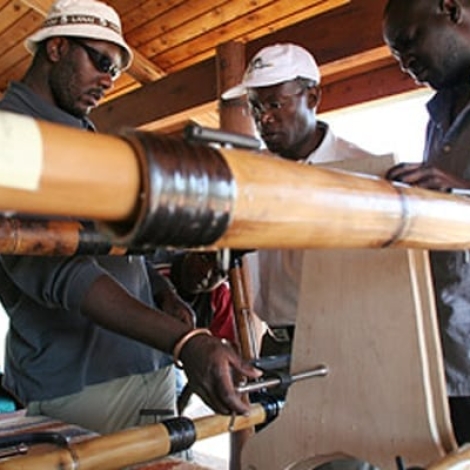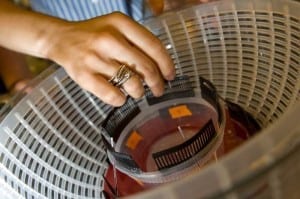Vaccines and other medical supplies travel to rural Kenyan communities on camel back. They are the chemical contingent of a mobile clinic called Mpala, which serves villages that are inaccessible by Jeep or Land Rover.
The vaccines are fragile and packed with ice into crates. The crates are strapped to wooden frames and borne around the camel’s hump. While traveling in the Kenyan heat, the ice can melt and the vaccines spoil.
To stem the waste, the supplies need a better cooling system. Because there’s plenty of sunlight, a solar-powered solution makes sense.
Winston Soboyejo and his students of mechanical and aerospace engineering at Princeton University hit on that idea. They have experimented with camel-borne, solar-powered refrigerator designs in the field.
They settled on an Engel portable refrigerator that holds about 14 quarts, equivalent to 20 12-ounce soft-drink cans. The photovoltaic (PV) cells are amorphous silicon, a thin-film material on floppy, rollable sheets. Once the cooling system and power supply details were worked out, the design lacked only a frame to cradle the refrigerator and prop up the panels while the camel walks.
Not all camels are created equal
The engineers needed a camel. “Gaining access to camels at Princeton is hard,” Soboyejo said drily. They took their design to the Bronx Zoo, where they fitted a frame to hold the refrigerators around a camel’s hump.
That gave the engineers a start, but they still had some barriers to overcome. Camels in New York are heartier and wider than their cousins in Ethiopia, and they can carry heavier loads.
The prototype frame fit the New York camels, but it was too cumbersome for the Ethiopian and Kenyan camels when the team took its design into the field.
Too smart
The second problem involved the frame itself. The aerospace engineers outdid themselves designing a trapezoidal aluminum frame that cupped the camel’s hump and supported the floppy PV panels so they’d be parallel to the ground while the camel walks. The idea was to give the panels optimum sun exposure.
Once in the field, however, they realized that the local camels could not support the weight of their frame for long distances. Also, it became apparent that the position of the panels was not as important as they had thought: the sun is so intense that even panels at inefficient angles can generate enough power for the refrigerators.
A local solution
“We went back to the drawing board and asked what do the local people do to make this work?” Soboyejo told E4C after a presentation he gave in Manhattan at the World Science Festival. The people who transported vaccines on camel back already had a frame that they used. “That was the solution. They used a cross bar in front, one in back and left room for the hump in the middle. I said, ‘why not make it out of bamboo?’” he recalled.
His students scrapped their aluminum frame and made improvements to the locally-created design. They developed a one-size-fits all feature of sliding poles that adjusts the frame to different-sized camels. And the PV panels hang at 45-degree angles, not horizontal.
“This is from the local culture,” Soboyejo said. “In five minutes the local people can look at this and know what to do. It’s a good case of learning from the local people.”
The Mpala clinic plans to use the new solar refrigerators in its next trip through the Laikipia district in central Kenya, scheduled for this month and next. After that trial run, Soboyejo will begin producing the camel saddles in his home country of Nigeria. They will be distributed there and in Ethiopia, and may be sold later in other parts of Africa and the Middle East.

